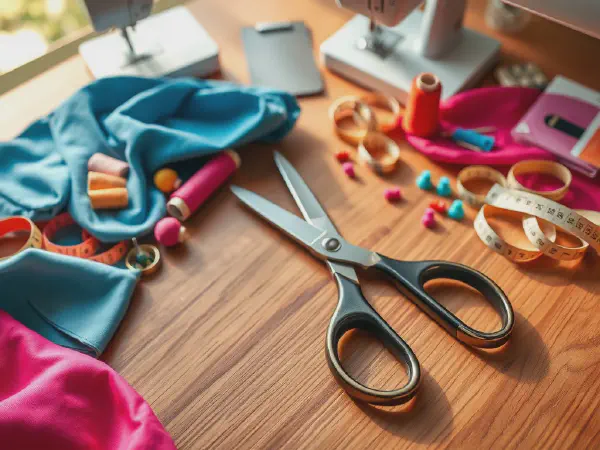Best Scissors for Fabric: A Comprehensive Guide for All Sewing & Crafting Needs

The Ultimate Guide to Fabric Scissors: Choosing the Right Scissors for Your Sewing and Crafting Projects
Scissors are indispensable tools for any sewing enthusiast or crafter. From delicate silk to heavy denim, the right pair of fabric scissors can make all the difference. This comprehensive guide dives deep into the world of fabric scissors, helping you choose the perfect tools for your specific needs. We'll cover different types, key features, top brands, and expert tips to elevate your cutting experience.
Understanding Different Types of Fabric Scissors
Not all scissors are created equal! Different types of fabric scissors are designed for specific tasks and materials. Here's a breakdown of the most common types:
Dressmaker's Shears
Dressmaker's shears, also known as tailor's shears, are the workhorses of any sewing room. They feature long blades (typically 7-12 inches) and a bent handle, allowing you to cut fabric flat on a surface without lifting the material. The bent handle is crucial for precise, consistent cuts. These shears are ideal for cutting out patterns, making long, straight cuts through multiple layers of fabric, and general fabric preparation.
Pinking Shears
Pinking shears are designed with a zigzag or sawtooth blade. They are primarily used to prevent fabric edges from fraying. The zig-zag cut creates a less likely to unravel edge, making them perfect for quilting, crafts, and finishing seams. They are a fantastic addition to any sewing kit to help preserve the longevity of your projects.
Quilting Scissors
Quilting scissors are specifically designed for the art of quilting, offering specialized features to make the job easier. These scissors are often smaller than dressmaker's shears and feature a sharp, pointed tip for precise cutting around templates and in tight corners. The small size and pointed tip can aid in detailed cutting and applique work. Some feature a spring-loaded action to reduce hand fatigue.
Embroidery Scissors / Thread Snips
Embroidery scissors, often called thread snips, are small, sharp scissors with pointed tips. They are perfect for intricate work, such as trimming threads in embroidery, cross-stitch, and other delicate needlework. Their fine points allow for precision cutting without damaging the surrounding fabric. Thread snips also excel at snipping threads close to the fabric surface.
Rotary Cutters
While not technically scissors, rotary cutters are an essential tool for many sewers and quilters. These tools feature a circular blade that rotates as you cut, allowing for straight, clean cuts. They are often used with a cutting mat and a ruler, making them ideal for quilting and other projects where accurate cuts are crucial. A rotary cutter is best when used with a cutting mat, which protects your work surface. These are fantastic for cutting multiple layers of fabric quickly.
Key Features to Consider When Choosing Fabric Scissors
Selecting the right fabric scissors involves considering several key features:
Blade Material and Sharpness
The blade material significantly impacts sharpness and durability. High-quality stainless steel blades are a popular choice for their sharpness, resistance to rust, and longevity. Titanium-coated blades offer even greater durability and are known to stay sharper for longer. It's essential to select blades that are precision-ground to ensure a clean, precise cut. Look for scissors that feel sharp right away – a good edge will make the task of cutting fabric much easier.
Handle Comfort and Ergonomics
Ergonomic handles are essential, particularly if you spend a lot of time cutting fabric. Look for handles with a comfortable grip, ideally with a soft or cushioned material to reduce hand fatigue. The shape of the handle should fit comfortably in your hand. Consider the size and weight of the scissors. Too heavy, and your hand will tire quickly; too small, and you might not have enough control. Many high-quality scissors feature molded handles that are designed to fit the natural curve of your hand. Consider the hand size you require and select the scissors that are the best fit.
Blade Length and Size
The blade length should match your typical projects. Longer blades are better for cutting long, straight lines, while shorter blades are ideal for intricate work. For dressmaker's shears, a blade length of 8-10 inches is generally recommended. For embroidery scissors, a shorter blade is more practical.
Blade Type
Consider the type of cutting you will be doing to determine the most appropriate blade type. Dressmaker's shears are generally best for cutting fabric. Pinking shears create a zig-zag effect. Embroidery scissors have pointed blades for precision work.
Top Brands of Fabric Scissors
Several brands are renowned for producing high-quality fabric scissors:
Fiskars
Fiskars is a well-known brand offering a wide range of scissors for various purposes, from general use to specialized fabric cutting. Their scissors are often praised for their value and durability.
Gingher
Gingher is a premium brand known for its high-end sewing scissors. They are made with top-quality materials and are prized for their precision and craftsmanship. Gingher is a favourite among dedicated sewers.
Kai
Kai is a Japanese brand celebrated for its exceptional quality and sharp, ergonomic designs. Their scissors are highly regarded by professionals.
Singer
Singer is a classic and reliable brand, offering a range of affordable and durable fabric scissors for both beginners and experienced sewers.
Choosing the Right Scissors for Different Fabrics
Different fabrics require different types of scissors and cutting techniques:
Scissors for Denim
Denim is a thick and durable fabric. Use heavy-duty dressmaker's shears with a sharp, strong blade. Cutting multiple layers of denim can be tough, so ensure your shears are up to the task. A good pair of denim shears can cut through multiple layers of thick fabric.
Scissors for Silk
Silk is delicate and can easily shift. Use sharp, pointed scissors like embroidery scissors or dressmaker's shears with a fine point for precise cuts. Be sure to use pins carefully to prevent the silk from slipping while cutting.
Scissors for Cotton
Cotton is a versatile fabric. Dressmaker's shears work well for most cotton projects. Make sure your blades are sharp for clean cuts. These scissors are also great for quilters.
Scissors for Leather
Cutting leather requires specialized tools, but you can use strong dressmaker's shears. Consider using a dedicated pair of scissors for leather, as the material can dull blades more quickly.
Scissors for Knit Fabrics
Knit fabrics can stretch and distort. Use dressmaker's shears and take extra care to ensure the fabric remains flat while cutting. Also consider using a rotary cutter on a cutting mat to achieve precise cuts. When cutting knit fabric, it's often helpful to use a serger to finish the edges, which will prevent fraying.
Tips for Cutting Fabric Like a Pro
- Use the Right Scissors: Always use scissors specifically designed for fabric.
- Prepare Your Fabric: Pre-wash and iron your fabric to prevent shrinkage and wrinkles.
- Place Fabric on a Flat Surface: Use a large cutting mat to protect your surface.
- Cut with Long, Smooth Strokes: Don't stop mid-cut.
- Sharpen Your Scissors Regularly: Use a scissor sharpener to maintain their sharpness.
- Use Proper Technique: Place the fabric flat on a surface. Cut with the full length of the blades, moving the scissors in a smooth, even motion. Use the bottom blade on the table while cutting for better control.
Frequently Asked Questions (FAQs)
What are the best scissors for cutting fabric?
The best scissors depend on the fabric and project. Dressmaker's shears are a versatile choice for general fabric cutting. Pinking shears prevent fraying. Quilting scissors are ideal for quilting. Embroidery scissors are excellent for delicate work. For accuracy, you might want to use a rotary cutter and a cutting mat.
Can I use regular scissors for fabric?
While you *can* use regular scissors in a pinch, it's not recommended. Regular scissors are not designed for fabric and may damage the material or dull quickly. Always use fabric-specific scissors for best results.
How do I sharpen fabric scissors?
Use a scissor sharpener designed for fabric scissors. Follow the manufacturer's instructions carefully. You can also have your scissors professionally sharpened.
What is the best way to cut multiple layers of fabric?
For multiple layers, use dressmaker's shears and ensure the blades are sharp. Use pins to secure the layers and cut slowly and carefully. You may also consider using a rotary cutter and cutting mat.
Conclusion
Choosing the right fabric scissors is essential for any sewing or crafting project. By understanding the different types of scissors, considering key features, and following our tips, you can find the perfect pair to meet your needs and elevate your cutting experience. Invest in high-quality scissors and treat them with care, and they will be a valuable tool for years to come. Whether you're working with denim, silk, or anything in between, the perfect pair of fabric scissors is waiting for you!
For additional information, check out our guides on Quilting Tools and Sewing Machine Basics.
